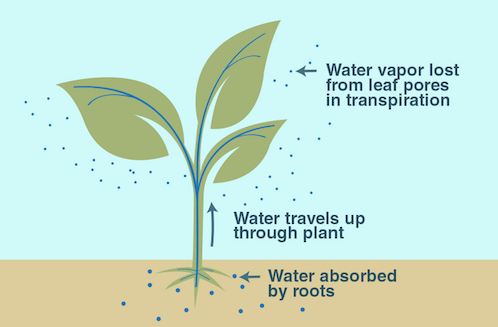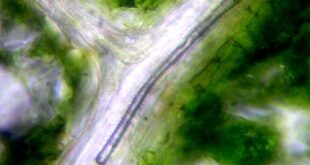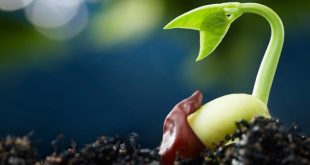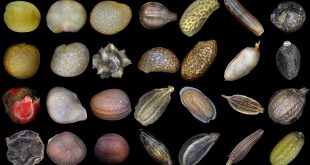Good to know
- A living cell can concentrate the solute, dead cell can’t.
- The suction pump can lift up to 34 ft in 1 atm pressure.
- Harry Cole tree was the highest plant up to 1988-89.
- Insoluble substances if added can not alter the osmotic potential. Only soluble substances can.
- Guard cell is living as it has a cell membrane.
- Xylem is a dead cell as it lacks a cell membrane.
Pumping system
Water is absorbed by the plant through the root. The absorbed water is transported to the leaf and ultimately passed out to the atmosphere through the stomata. The water molecules inside the plant both in the shoot and root create a water column. As the water potential is low out in the atmosphere, each time a water hydrogen bond breaks down in the stomata and a molecule is released in the atmosphere. Thus tension (from top to bottom) is created in the chain and so another molecule is added to the other end of the water column at the root hair. In this way, the system continues…..
The driving force in this mechanism is the evaporation of water from the surface of the leaf (transpiration). The evaporation causes tension which results in the pull of the water column and ultimately water comes out of the stomata.
So, transpiration is the driving force of water movement inside the plant.
Tension
- It is a measurable quantity.
- Ψp = measure of how much tension the water column experiences.
- Ψw or Ψ= water potential.
- Ψs = solute potential or, the measure of solute dissolved in the water.
- Ψp = pressure potential.
Transpiration
The loss of excess water from the aerial parts of plants in the form of water vapor is known as transpiration.
There are three kinds of transpiration:
- Stomatal transpiration
- Cuticular transpiration
- Lenticular transpiration
Organ of water transpiration: Stomata
Most of the transpiration takes place through the stomata. Stomatal openings on the leaf make up only about 1% of the surface area.
In mesophyte or land plants,
- The lower epidermis contains stomata more. They are also likely to be found in the cuticularised upper epidermis but very few in number.
- Grasses usually have an equal number of stomata on each side.
In hydrophytes,
- The upper surface of floating leaves contains stomata.
- In submerged plants, there are no stomata.
Stomata contain a pore called the stomatal pore surrounded by two guard cells. The inner wall of the cells toward the pore is very thick and the outer wall away from the pore is thin. Typically guard cells contain a few chloroplasts, whereas their neighboring epidermal cells usually do not (except in ferns and in some aquatic angiosperms). Typically, there are no (or incomplete) plasmodesmata connecting the protoplasts of guard cells and accessory cells, but there may be plasmodesmata between guard cells and mesophyll cells below.
The guard cells have different shapes and arrangements in monocot and dicot plants.
In dicot plants, the guard cells are
- Normally bean-shaped or kidney-shaped.
- Scattered in the arrangement.
E.g.
In monocot plants, the guard cells are
- Dumbell shaped.
- Linear in the arrangement.
E.g. Grass, sedge, etc.
The guard cells are again surrounded by 4 to 5 epidermal cells. These epidermal cells are also called subsidiary or accessory cells.
- These cells are usually larger than the adjacent cells.
- Chloroplasts are absent in subsidiary cells.
The waxy cuticle on leaf surfaces restricts diffusion, so most water vapor and other gases must pass through the opening between the guard cells.
Effects of light quality on stomata
Sharkey and Raschke (1981) measured the wavelengths of light that were most effective in causing stomata to open. Blue light (430 to 460 nm) was nearly 10 times as effective as red light (630 to 680 nm) in producing a given stomatal opening. There was only a slight response to the green light.
The red light response is apparently caused by light absorbed by chlorophyll, but the blue light effect is independent of photosynthesis.
Edwardo Zeiger and Peter Hepler (1977) showed that blue light would cause isolated guard cell protoplasts to absorb K+ ions and swell, which in intact stomata is what causes stomatal opening.
Does photosynthesis occur in guard cells?
- Photosynthesis was detected in isolated guard cell protoplasts (Gotow et al., 1988) but the maximum rate was below the rate of dark respiration.
- Guard cells contain only 3% as many chlorophylls as mesophyll cells.
Mechanism of stomatal transpiration
…………………………………………………………………………………………………………………………………………………………………………………………….
Mechanism of stomatal movement (Stomatal opening and closing)
- Turgor pressure, Ψp is the pressure applied on the wall of the guard cell from inside of it.
- Water enters the guard cell and it starts swelling and pressure is created inside the guard cell. Up to a certain limit, it expands and at the highest point, it becomes turgid. So, it resists and creates turgor pressure.
- The consequence of the turgor pressure is the wall pressure which is exerted by the elastic cell wall against the expanding protoplasm. At a given time turgor pressure (T.P) equals the wall pressure (W.P).
T.P = W.P
1st theory: Starch-sugar interconversion theory
This classical theory is based on the effect of pH on starch phosphorylase enzyme which reversibly catalyzes the conversion of starch + inorganic phosphate into glucose-1-phosphate.
During the daytime, CO2 concentration is low in guard cells because of photosynthesis. Hence the pH of the guard cells will increase favoring the hydrolysis of insoluble starch into soluble glucose-1-phosphate. So, osmotic potential becomes lower in the guard cells. Consequently, water enters the guard cells by osmotic diffusion from the surrounding cells. Guard cells become turgid and stomata open.


Scientist Steward (1964) modified the scheme of this theory. According to him, the conversion of starch and inorganic phosphate into glucose-1-phosphate doesn’t do any appreciable change in the osmotic pressure because the inorganic phosphate and the glucose-1-phosphate are equally active osmotically (which means equally soluble). In this scheme, he has suggested that,
- Glucose-1-phosphate should be further converted into glucose and inorganic phosphate for the opening of stomata.
- Metabolic energy in the form of ATP would be required for the closing of stomata which probably comes through respiration.
Drawbacks
- A very small amount of osmotically active sugars have been extracted from guard cells.
- Phosphorylase is primarily involved with starch degradation rather than its synthesis.
- The chloroplasts of guard cells aren’t functional. So, starch is supplied by mesophyll tissue.
2nd theory: Synthesis of sugar and organic acid in guard cell theory
During daylight, as a result of photosynthesis CO2 concentration in guard cells decreases which lead to increased pH in them. There may be some builds of organic acid chiefly malic acid during this period in the guard cells. The formation of malic acid would produce protons that could operate in an ATP-driven H+-K+ exchange pump moving protons into the adjacent epidermal cells and K+ ions into the guard cells and thus may contribute to decreasing water potential in the guard cells and leading to stomatal opening.
Reaction

(Starch is apparently broken down to produce a three-carbon compound called PEP; this step is promoted by blue light. The PEP then combines with CO2, producing the 4-C oxalic-acetic acid, which is converted into malic acid. Finally, H ions from the malic acid leave the cell, balancing the K ions that are entering
Figure
Good to know
- PEP stands for Phosphoenolpyruvate (3 Carbon compound).
- PEP is a CO2 acceptor in Hatch and Slack pathway.
Good to know
Rubisco enzyme
- The most abundant enzyme in the world.
- Essential for photosynthesis.
- Significance:
Phosphynol-1,5-bisphosphate, Phosphoenolpyruvate.
Only Ribulose-1,5-bisphosphate and phosphoenolpyruvate can capture CO2. - The most abundant sugar is starch. Its source is non-cyclic photophosphorylation.
3rd theory: ATP-driven H+ – K+ exchange pump theory
- Most widely accepted theory.
According to this theory, there is an accumulation of K+ ions in the guard cells during the daylight period. The K+ are ‘pumped out’ from the guard cells into the adjacent epidermal cells and in exchange K+ ions are ‘pumped in’ into them from the adjacent epidermal cells.
This exchange of H+ and K+ ions is followed by the entry of Cl- ions into the guard cells which results in response to the electrical differential in the guard cells due to the accumulation of K+ ions in them (to maintain electrical neutrality).
The exchange of H+ and K+ ions is mediated through ATP and thus is an active process. ATP is generated in non-cyclic photophosphorylation in photosynthesis in the guard cells. The ATP may also come from respiration.
The accumulation of K+ in guard cells is accompanied by increased pH and organic acid (chiefly malic acid) buildup. The formation of malic acid would produce protons that could operate in H+ and K+ exchange process. The remaining organic acid anions are neutralized by K+ ions in the guard cells.
The accumulation of K+ ions together with Cl- ions, and anions of organic acid is sufficient enough to significantly decrease the water potential of guard cells during daylight. Increases of up to 0.5 M in K+ concentration are observed, enough to decrease the water potential by about 2.0 MPa. Consequently, water enters into them from the adjacent epidermal and mesophyll cells thereby increasing the turgor pressure and opening the stomatal pore.
The reverse situation occurs in dark.
- Abscisic acid causes loss of K+ from the guard cells.
- Succulent plants open their stomata at night.
Figure
Importance of transpiration
Usefulness
- Water absorption and translocation are controlled.
- Mineral nutrient translocation.
- Internal temperature is regulated somewhat.
Harmfulness
- Excess transpiration in case of water deficiency hampers the metabolic activity of plants which ultimately causes their wilting.
- Leaf fall occurs to check transpiration.
- Excess energy is needed to release excess water.
- Transpiration (wastage of energy) is called a necessary evil.
Understanding stomatal opening and closing in light of potential (Ψ)
Important note
- Ψp = Pressure potential which is +’ve for turgor pressure and –‘ve for tension.
- Ψ = Ψp + Ψπ
- The Ψp of a lake is zero as there is no membrane in the lake.
- Ψπ = -CiRT where Ψπ is the osmotic potential (O.P) and C is the molar concentration.
For non-electrolytes, i = 1
For electrolytes, i < .1
- Ψπ = -CRT for non-electrolytes.
- In living cells Ψp is negligible.
From the subsidiary cells, water enters into the guard cells (Ψ is less inside). As a result, they expand and the pore opens.
In reverse cases, when Ψ is more inside but less outside of guard cells, water goes out. The cells become placid and the stomata close.
A semipermeable membrane allows some particular ions to transfer.
Solute-containing ions enter the guard cells and decrease the water potential.
| Stomata open | Stomata close | |||
| Ψ | Guard cell | E.P | Guard cell | E.P |
| Ψπ | -8 | -4 | -2 | -6 |
| Ψp | 5 | 3 | 1 | 4 |
| Ψw | -3 | -1 | -1 | -2 |
| Direction | ← | → | ||
E.P. is epidermal cell.
To find the direction of movement of water, note the Ψw, not other potentials.
Xylem and parenchymatous cells
- Xylems and parenchymatous cells are in equilibrium as both have the same water potential. So, there is no exchange of water between them.
| Ψ | Ψπ | Ψp (Tension) | |
| Xylem | -8 | -.5 | -7.5 |
| Parenchyma | -8 | -11 | +3 (?) |
- The xylem contains almost the same amount of ions as the soil (?).
Problem 1:

Delving into details
Consider water potentials in the soil-plant-water system. Under most conditions, water potential is highest in the soil and lowest in the atmosphere, with intermediate values in various parts of the plants; that is, there is a gradient from the soil, through the plant, to the atmosphere. But the components of the water potential vary. In wet soil above the water table, Ψp = 0 and Ψs is only slightly negative because the soil solution is dilute, so Ψ is also only slightly negative. Xylem sap is very dilute, so Ψs is only slightly negative; but the water is always virtually always under tension (Ψp is negative), so Ψ is more negative in the xylem than in the soil water, which moves into the plant from the soil. In leaf cells, which contain a more concentrated solution, Ψs is quite negative; water moves in and builds up a positive Ψp, but water is continuously evaporating from these cells, so Ψp does not increase as much as it otherwise would (that is, equilibrium is not reached), and Ψ in the cells remains more negative than in the xylem. Atmospheric Ψ is even more negative, so water tends to evaporate and move out of the leaves and into the atmosphere.
In the phloem, the following happens

From the leaf, carbohydrates enter the phloem and go down the cell. In the meantime, water comes from the xylem to the phloem cell. In the next step, only the carbohydrates not water passes from the phloem to the root cell.
The food entering the phloem creates pressure at the top of the phloem.
Good to know
- More than 90% of a cell is water.
- What happens in Lojjaboti plants??
- Touch the plant.
- A small electric current will be generated.
- Pumping out of K+ from the leaf.
- Loss of turgor pressure.
- Leaf collapses.
 Plantlet The Blogging Platform of Department of Botany, University of Dhaka
Plantlet The Blogging Platform of Department of Botany, University of Dhaka






something different. really enjoyed a lot
Clear and accurate explanations. Very informative and easily assimilated. Thank you.
Thank you
Reading your article helped me a lot and I agree with you. But I still have some doubts, can you clarify for me? I’ll keep an eye out for your answers.
I am currently writing a paper and a bug appeared in the paper. I found what I wanted from your article. Thank you very much. Your article gave me a lot of inspiration. But hope you can explain your point in more detail because I have some questions, thank you.